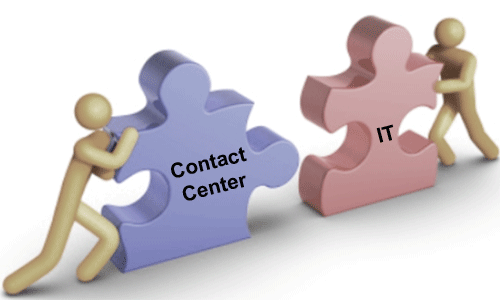Contact centers have matured in their operational requirements and sophistication, as evidenced on a few fronts.
- Siloed multichannel, multimedia offerings are giving way to the quest for seamless, integrated, omnichannel service delivery.
- Managers join folks on the front-line in the quest for better desktop applications and knowledge sources.
- Managers are placing increased emphasis on performance management and the corresponding use of tools.
- Forward thinking companies deploy improved web and mobile apps for customers and desktop and mobile apps for agents and supervisors.
 While leaders have pretty good “wish lists” of things they want for their centers, IT is often too darn busy to tackle these initiatives. In fairness, they’re in a state of flux due to changes in technology, internal resources (numbers and/or expertise), and user demands. We’ve seen two primary responses to this transition:
While leaders have pretty good “wish lists” of things they want for their centers, IT is often too darn busy to tackle these initiatives. In fairness, they’re in a state of flux due to changes in technology, internal resources (numbers and/or expertise), and user demands. We’ve seen two primary responses to this transition:
IT may be trying to manage all technology, but not always hanging on. In this case, IT is still managing their own systems, networks, and data centers, either because it is a core competency or viewed as mission critical, or both. They want to manage contact center technology as well and may be reluctant to relinquish control of an area they traditionally owned. However, some are now seeing the opportunity to peel off contact center technology as a function of losing specialized expertise and/or the desire to maintain it. In these cases, contact center technology is no longer a top IT priority, and many other things can overshadow it – from projects to firefighting to the latest hot topic, such as fraud.
IT may be moving away from technology responsibilities not central to their business. This model may be catalyzed by cloud solutions across many application areas, along with those simpler user interfaces that don’t require a programmer. IT departments must make choices when faced with the reality of too few people to support too many tasks. They have growing responsibilities in core systems, networks, and data tied to compliance, security/fraud protection, BC/DR, and more. They also need to have more knowledge systems, customer data, and enhanced applications to be competitive and support business needs. They declare they “don’t want to be in the data center business.” They are OK with cloud contact center technology and the center doing more as long as it meets their security, reliability, BC/DR, and architecture needs and doesn’t jeopardize other elements of IT infrastructure and applications.

Fortunately, technology has become more user-friendly on both the administrative and configuration fronts. Contact center leaders are increasingly ready, willing, and able to take on more contact center technology responsibility.
While the right technology may be a necessary condition to shore up known deficiencies, the number one factor holding centers back may well be lack of dedicated support resources. Technology implementation must be paired with effective project management, change management, and vendor management to create a successful launch. Then, centers must invest in analytical and administrative skills to optimize technology use and provide actionable feedback to the organization. Transformation cannot occur when implementation and ongoing support are relegated to “spare time” efforts.
Want to learn more? Download the full article to get our top tips for optimizing new or existing technology to the benefit of the contact center and IT »
